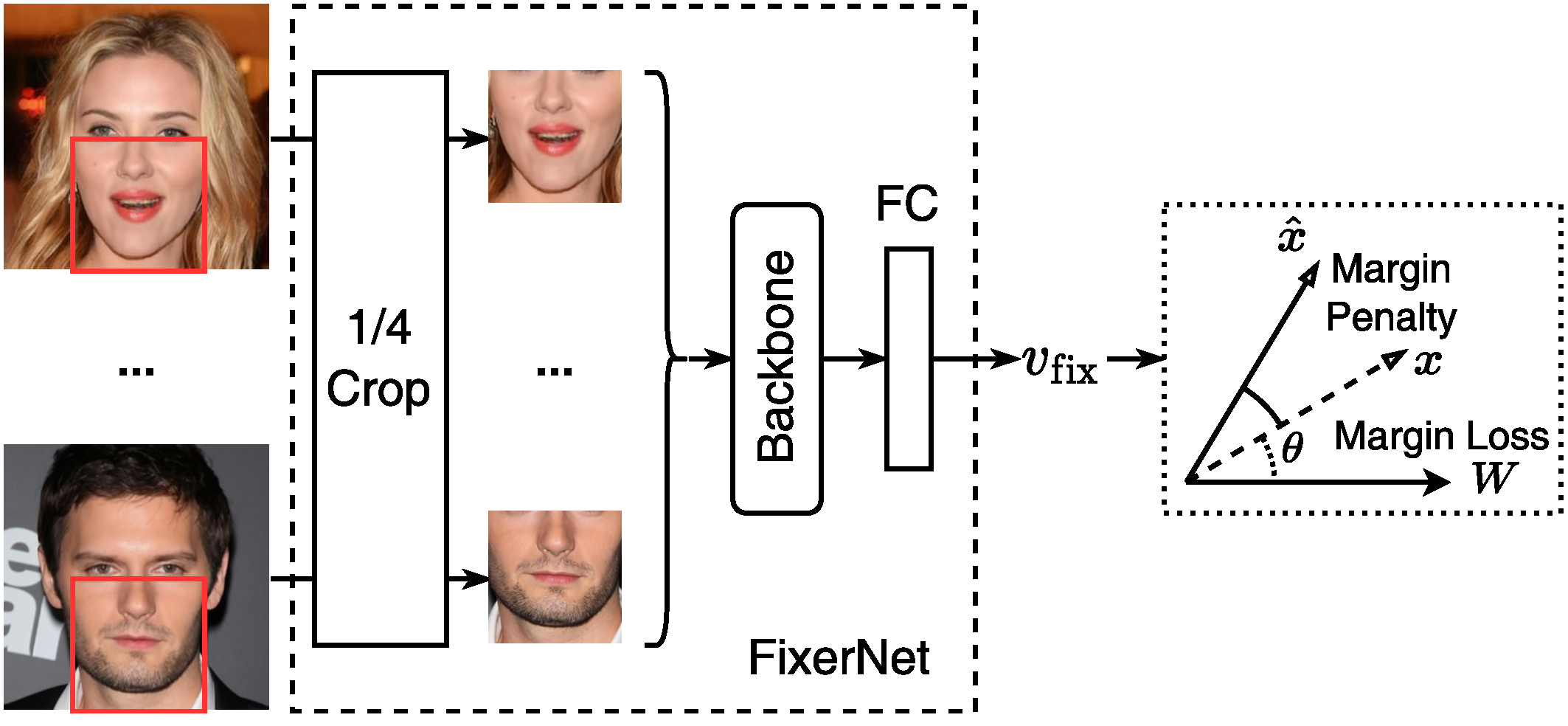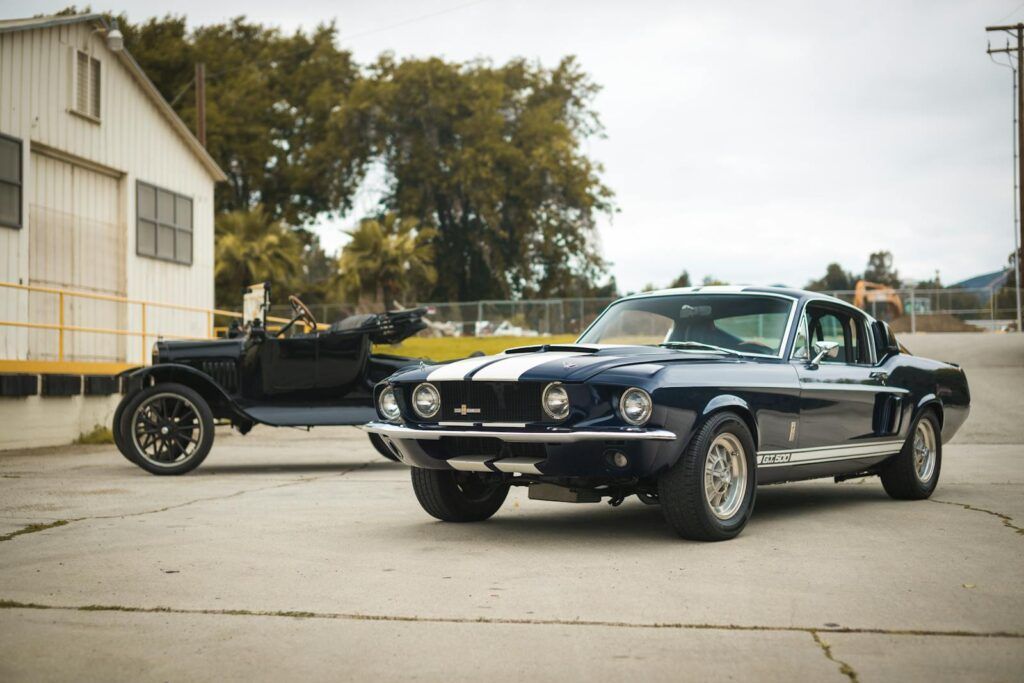
The Ford Mustang, an enduring icon of American automotive culture, has captivated car enthusiasts since its debut in 1964. Known for its sleek design, powerful performance, and unmistakable emblem, the Mustang’s rich history is filled with intriguing details that have contributed to its legendary status. While many are familiar with its general history, several surprising aspects highlight its significance in the automotive industry and popular culture.
From its unexpected debut at the New York World’s Fair to its numerous appearances in movies and television shows, the Mustang continues to be a symbol of freedom and innovation. Its journey spans over six decades, succeeding where so many of its competitors failed, and evolving into a tribute to itself. This remarkable endurance has inspired individuals to fall in love with it all over again, year after year.
Even for the most dedicated Mustang fans, there are fascinating facts and little-known details that remain under the radar. We’ve compiled a list of unique insights, rare milestones, and groundbreaking achievements that truly showcase why the Mustang is not just a car, but an evolving legend. Prepare to uncover some hidden gems about this beloved pony car that might just surprise even the most seasoned enthusiasts.

1. **Ford Designed a “Mustang I” Concept Car in 1962**Before the legendary Mustang we know today, Ford created the “Mustang I” concept car in 1962. This early prototype was a two-seater, mid-engine sports car, a radical departure from the four-seater production model that would capture the public’s imagination just two years later. Its sharp, futuristic design bore little resemblance to the classic pony car, hinting at a very different direction for the nameplate.
The “Mustang I” wasn’t just a design exercise; it featured advanced engineering for its time. It boasted a lightweight aluminum body, which was quite innovative for a vehicle being developed by a major American automaker. Underneath its sleek skin, it was powered by a V4 engine, a significant contrast to the V8 engines that would become synonymous with the production Mustang’s performance image.
Although this concept car never went into production, it generated significant interest and excitement. It served as a crucial stepping stone, laying the groundwork for the Mustang’s eventual design and demonstrating Ford’s willingness to experiment and innovate in the burgeoning sports car market. This early foray into performance vehicle concepts ultimately helped Ford understand what the public desired, even if it wasn’t this exact machine.
Car Model Information: 2024 GMC Sierra 1500 SLT
Caption: Ford Mustang I at the Henry Ford Museum
Name: Ford Mustang I
Manufacturer: Ford Motor Company
Class: Concept car
BodyStyle: Roadster (automobile)
Layout: mid-engine layout
Engine: cvt
Platform: Experimental
Wheelbase: cvt
Length: cvt
Width: cvt
Height: cvt
Weight: cvt
Designer: Eugene Bordinat,Roy Lunn,John Najjar
Categories: Articles with short description, Commons category link from Wikidata, Ford Mustang, Ford concept vehicles, Short description is different from Wikidata
Summary: The Ford Mustang I is a small, mid-engined (4-cylinder), open two-seater concept car with aluminium body work that was built by Ford in 1962. Although it shared few design elements with the final production vehicle, it did lend its name to the line.
Get more information about: Ford Mustang I
Buying a high-performing used car >>>
Brand: Ford Model: Mustang I
Price: $43,759 Mileage: 32,694 mi.

2. **The Mustang Wasn’t Named After a Horse**It’s a tough one to swallow for many, especially given the iconic galloping horse emblem and the coining of the term “pony car,” but the Ford Mustang wasn’t actually named after the majestic animal. This piece of Mustang lore often surprises even long-time enthusiasts, challenging a deeply ingrained assumption about the vehicle’s identity. The true origin of its name takes us back to a different kind of horsepower.
Two decades before Ford introduced its revolutionary car, the Second World War raged, and aviation saw considerable advancements. During this era, a highly advanced fighter plane, the P-51 Mustang, emerged as a dominant force in the skies over Europe. This renowned aircraft was celebrated for its speed, agility, and exceptional performance, attributes that captured the imagination of many.
John Najjar, a co-designer of the original Mustang prototype, was particularly preoccupied with the elegance, power, and beauty of the P-51. When the time came to suggest a name for Ford’s revolutionary new car, he proposed the P-51’s nickname: Mustang. This naming decision was a deliberate choice, intended to align the car with the fighter plane’s legacy of excellence, heroism, power, and American ingenuity, not the quadruped.
Though the Mustang did eventually adopt its famous galloping horse emblem, the name’s true roots are cherished by a dedicated segment of Mustang enthusiasts. Celebrated Mustang modifier Jack Roush, for instance, a man who even owns an actual P-51 Mustang fighter plane, paid a direct homage to this namesake. He did so with a customized 727-horsepower 2017 Ford Mustang painted in the combat aircraft’s distinctive silver-and-black livery, a clear nod to its aerial inspiration.
Car Model Information: 2008 Ford Mustang GT Premium
Name: Ford Mustang
Caption: 2018 Ford Mustang GT 5.0
Aka: Ford T5 (Germany)
Manufacturer: Ford Motor Company
Production: March 1964 – present
ModelYears: 1965–present
Class: Unbulleted list
BodyStyle: Unbulleted list
Layout: Front-engine, rear-wheel-drive layout
Categories: 1970s cars, 1980s cars, 1990s cars, 2+2 coupés, 2000s cars
Summary: The Ford Mustang is an American automobile manufactured and marketed by Ford since 1964, as Ford’s longest nameplate in continuous production. Currently in its seventh generation, it is the fifth-best selling Ford car nameplate. The namesake of the “pony car” automobile segment, the Mustang was developed as a highly styled line of sporty coupes and convertibles derived from existing model lines, initially distinguished by its pronounced “long hood, short deck” proportions.
Originally predicted to sell 100,000 vehicles yearly, the 1965 Mustang became the most successful vehicle launch since the 1927 Model A. Introduced on April 17, 1964 (16 days after the Plymouth Barracuda), over 400,000 units were sold in its first year; the one-millionth Mustang was sold within two years of its launch. In August 2018, Ford produced the 10-millionth Mustang; matching the first 1965 Mustang, the vehicle was a 2019 Wimbledon White convertible with a V8 engine.
The success of the Mustang launch led to multiple competitors from other American manufacturers, including the Chevrolet Camaro and Pontiac Firebird (1967), AMC Javelin (1968), and Dodge Challenger (1970). It also competed with the Plymouth Barracuda, which was launched around the same time. The Mustang also had an effect on designs of coupes worldwide, leading to the marketing of the Toyota Celica and Ford Capri in the United States (the latter, by Lincoln-Mercury). The Mercury Cougar was launched in 1967 as a unique-bodied higher-trim alternative to the Mustang; during the 1970s, it included more features and was marketed as a personal luxury car.
From 1965 until 2004, the Mustang shared chassis commonality with other Ford model lines, staying rear-wheel-drive throughout its production. From 1965 to 1973, the Mustang was derived from the 1960 Ford Falcon compact. From 1974 until 1978, the Mustang (denoted Mustang II) was a longer-wheelbase version of the Ford Pinto. From 1979 until 2004, the Mustang shared its Fox platform chassis with 14 other Ford vehicles (becoming the final one to use the Fox architecture). Since 2005, the Mustang has used the D2C platform, unique to the Mustang.
Through its production, multiple nameplates have been associated with the Ford Mustang series, including GT, Mach 1, Boss 302/429, Cobra (separate from Shelby Cobra), and Bullitt, along with “5.0” fender badging (denoting 4.9 L OHV or 5.0 L DOHC V8 engines).
Get more information about: Ford Mustang
Buying a high-performing used car >>>
Brand: Ford Model: Mustang
Price: $16,785 Mileage: 81,832 mi.
Read more about: 14 Unlikely Automotive Heroes: The Cars That Shocked Everyone and Redefined Success
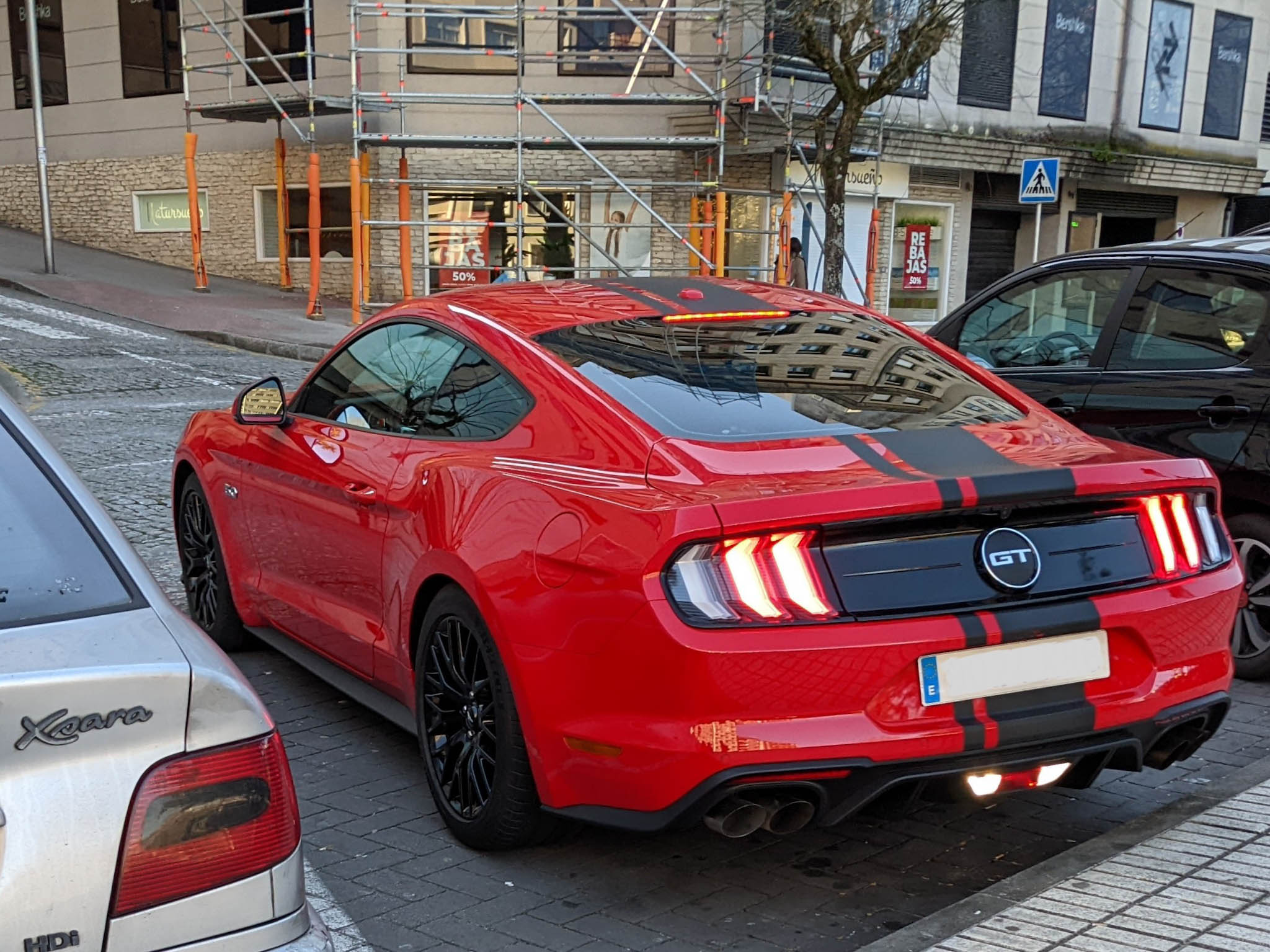
3. **The Mustang Almost Went Front-Wheel Drive**Imagine a Mustang without its signature rear-wheel drive, a core characteristic that defines muscle and pony cars alike. It might sound like automotive heresy, but Ford actually came perilously close to making this exact mistake when pondering the future of the fourth-generation Mustang. This surprising chapter in Mustang history could have fundamentally altered the car’s identity and legacy.
During the 1980s, the popular Fox-body Mustang, while beloved, was seen by some as a shadow of its former self. Gas crises and tightening environmental regulations had gutted the pony car’s once proud tradition of “no-replacement-for-displacement” ethos. In this climate, front-wheel-drive vehicles grew increasingly popular, and Japanese imports like the Acura Integra and Toyota Celica began to eat into the market share.
Faced with these pressures, Ford, which had a working relationship with Mazda, considered a drastic solution: replacing the Mustang with a Mazda coupe. The major catch? This vehicle’s front-wheel-drive architecture simply couldn’t handle a V8 engine, meaning Mustang lovers would have to settle for a V6. This proposition was met with an immediate and severe backlash from the public.
When news of the possible redesign reached the public, a massive letter-writing campaign erupted, fueled by disgust from media outlets and devoted fans. Thankfully, the Ford executives, not all of whom were keen on the idea in the first place, ultimately shut down the endeavor. If you’ve ever wondered what a front-wheel-drive Ford Mustang might have been like, you need look no further than every Ford Probe model – it’s the direct result of that moment of consideration.
Car Model Information: 2008 Ford Mustang GT Premium
Name: Ford Mustang
Caption: 2018 Ford Mustang GT 5.0
Aka: Ford T5 (Germany)
Manufacturer: Ford Motor Company
Production: March 1964 – present
ModelYears: 1965–present
Class: Unbulleted list
BodyStyle: Unbulleted list
Layout: Front-engine, rear-wheel-drive layout
Categories: 1970s cars, 1980s cars, 1990s cars, 2+2 coupés, 2000s cars
Summary: The Ford Mustang is an American automobile manufactured and marketed by Ford since 1964, as Ford’s longest nameplate in continuous production. Currently in its seventh generation, it is the fifth-best selling Ford car nameplate. The namesake of the “pony car” automobile segment, the Mustang was developed as a highly styled line of sporty coupes and convertibles derived from existing model lines, initially distinguished by its pronounced “long hood, short deck” proportions.
Originally predicted to sell 100,000 vehicles yearly, the 1965 Mustang became the most successful vehicle launch since the 1927 Model A. Introduced on April 17, 1964 (16 days after the Plymouth Barracuda), over 400,000 units were sold in its first year; the one-millionth Mustang was sold within two years of its launch. In August 2018, Ford produced the 10-millionth Mustang; matching the first 1965 Mustang, the vehicle was a 2019 Wimbledon White convertible with a V8 engine.
The success of the Mustang launch led to multiple competitors from other American manufacturers, including the Chevrolet Camaro and Pontiac Firebird (1967), AMC Javelin (1968), and Dodge Challenger (1970). It also competed with the Plymouth Barracuda, which was launched around the same time. The Mustang also had an effect on designs of coupes worldwide, leading to the marketing of the Toyota Celica and Ford Capri in the United States (the latter, by Lincoln-Mercury). The Mercury Cougar was launched in 1967 as a unique-bodied higher-trim alternative to the Mustang; during the 1970s, it included more features and was marketed as a personal luxury car.
From 1965 until 2004, the Mustang shared chassis commonality with other Ford model lines, staying rear-wheel-drive throughout its production. From 1965 to 1973, the Mustang was derived from the 1960 Ford Falcon compact. From 1974 until 1978, the Mustang (denoted Mustang II) was a longer-wheelbase version of the Ford Pinto. From 1979 until 2004, the Mustang shared its Fox platform chassis with 14 other Ford vehicles (becoming the final one to use the Fox architecture). Since 2005, the Mustang has used the D2C platform, unique to the Mustang.
Through its production, multiple nameplates have been associated with the Ford Mustang series, including GT, Mach 1, Boss 302/429, Cobra (separate from Shelby Cobra), and Bullitt, along with “5.0” fender badging (denoting 4.9 L OHV or 5.0 L DOHC V8 engines).
Get more information about: Ford Mustang
Buying a high-performing used car >>>
Brand: Ford Model: Mustang
Price: $16,785 Mileage: 81,832 mi.
Read more about: 14 Unlikely Automotive Heroes: The Cars That Shocked Everyone and Redefined Success
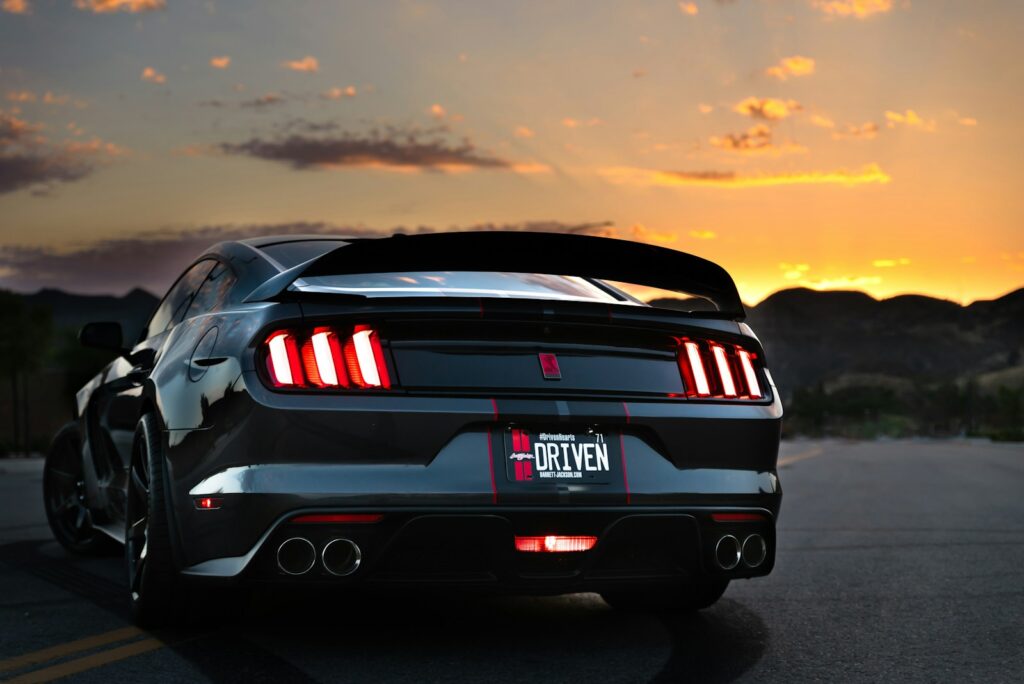
4. **A Mid-Engine Mustang Almost Happened**The concept of a mid-engine sports car is synonymous with superior balance, improved traction, and razor-sharp handling, attributes highly sought after in the world’s best performance vehicles. From Porsche’s unwavering devotion to the configuration to the C8 Corvette’s recent adoption, mid-ship vehicles have more than proven their mettle. What might come as a genuine surprise is that Ford considered, and even built, a mid-engine Mustang back in the 1960s.
This wasn’t just any Mustang, either; it was based on the legendary Mustang Boss 429, a high-performance variant featuring a massive big block engine. Ford engineers, however, were reportedly dissatisfied with all that weight hanging over the front end of the car, especially for a vehicle intended for serious performance. This led them to explore a radical solution to optimize weight distribution.
In a bold move, Ford’s engineers flipped the colossal iron-blocked engine around and repurposed the former engine compartment to house cooling and electrical equipment, a setup not unlike the supercars of today. This experimental vehicle, known as the LID Mustang, seemed to offer the best of all worlds: a European-style engine location combined with raw, untamed American power. It was a fascinating glimpse into what could have been.
So, with such a promising configuration, why didn’t Ford go mid-ship with the Mustang? The primary reason was practical: the shift in weight, surprisingly, didn’t provide any significant performance enhancements that would justify the immense cost. Retooling the production lines to mass-produce the mid-ship Mustang would have been an expensive and ultimately futile endeavor. The Mustang LID, unfortunately, disappeared from history.
Its fate remains shrouded in mystery, with some claiming it went directly to the crusher, and others suggesting it sat in a wrecking yard for a few years before vanishing completely. The enigma surrounding its disappearance only adds to the intrigue, allowing enthusiasts to imagine the mid-ship monster still out there, perhaps huddling in the shadows of some garage, awaiting a glorious, unforeseen return to the spotlight.
Car Model Information: 2008 Ford Mustang GT Premium
Name: Ford Mustang
Caption: 2018 Ford Mustang GT 5.0
Aka: Ford T5 (Germany)
Manufacturer: Ford Motor Company
Production: March 1964 – present
ModelYears: 1965–present
Class: Unbulleted list
BodyStyle: Unbulleted list
Layout: Front-engine, rear-wheel-drive layout
Categories: 1970s cars, 1980s cars, 1990s cars, 2+2 coupés, 2000s cars
Summary: The Ford Mustang is an American automobile manufactured and marketed by Ford since 1964, as Ford’s longest nameplate in continuous production. Currently in its seventh generation, it is the fifth-best selling Ford car nameplate. The namesake of the “pony car” automobile segment, the Mustang was developed as a highly styled line of sporty coupes and convertibles derived from existing model lines, initially distinguished by its pronounced “long hood, short deck” proportions.
Originally predicted to sell 100,000 vehicles yearly, the 1965 Mustang became the most successful vehicle launch since the 1927 Model A. Introduced on April 17, 1964 (16 days after the Plymouth Barracuda), over 400,000 units were sold in its first year; the one-millionth Mustang was sold within two years of its launch. In August 2018, Ford produced the 10-millionth Mustang; matching the first 1965 Mustang, the vehicle was a 2019 Wimbledon White convertible with a V8 engine.
The success of the Mustang launch led to multiple competitors from other American manufacturers, including the Chevrolet Camaro and Pontiac Firebird (1967), AMC Javelin (1968), and Dodge Challenger (1970). It also competed with the Plymouth Barracuda, which was launched around the same time. The Mustang also had an effect on designs of coupes worldwide, leading to the marketing of the Toyota Celica and Ford Capri in the United States (the latter, by Lincoln-Mercury). The Mercury Cougar was launched in 1967 as a unique-bodied higher-trim alternative to the Mustang; during the 1970s, it included more features and was marketed as a personal luxury car.
From 1965 until 2004, the Mustang shared chassis commonality with other Ford model lines, staying rear-wheel-drive throughout its production. From 1965 to 1973, the Mustang was derived from the 1960 Ford Falcon compact. From 1974 until 1978, the Mustang (denoted Mustang II) was a longer-wheelbase version of the Ford Pinto. From 1979 until 2004, the Mustang shared its Fox platform chassis with 14 other Ford vehicles (becoming the final one to use the Fox architecture). Since 2005, the Mustang has used the D2C platform, unique to the Mustang.
Through its production, multiple nameplates have been associated with the Ford Mustang series, including GT, Mach 1, Boss 302/429, Cobra (separate from Shelby Cobra), and Bullitt, along with “5.0” fender badging (denoting 4.9 L OHV or 5.0 L DOHC V8 engines).
Get more information about: Ford Mustang
Buying a high-performing used car >>>
Brand: Ford Model: Mustang
Price: $16,785 Mileage: 81,832 mi.
Read more about: Barn Find Billions: Unearthing 11 Ultra-Rare ’60s Chevy Models That Could Make You Rich
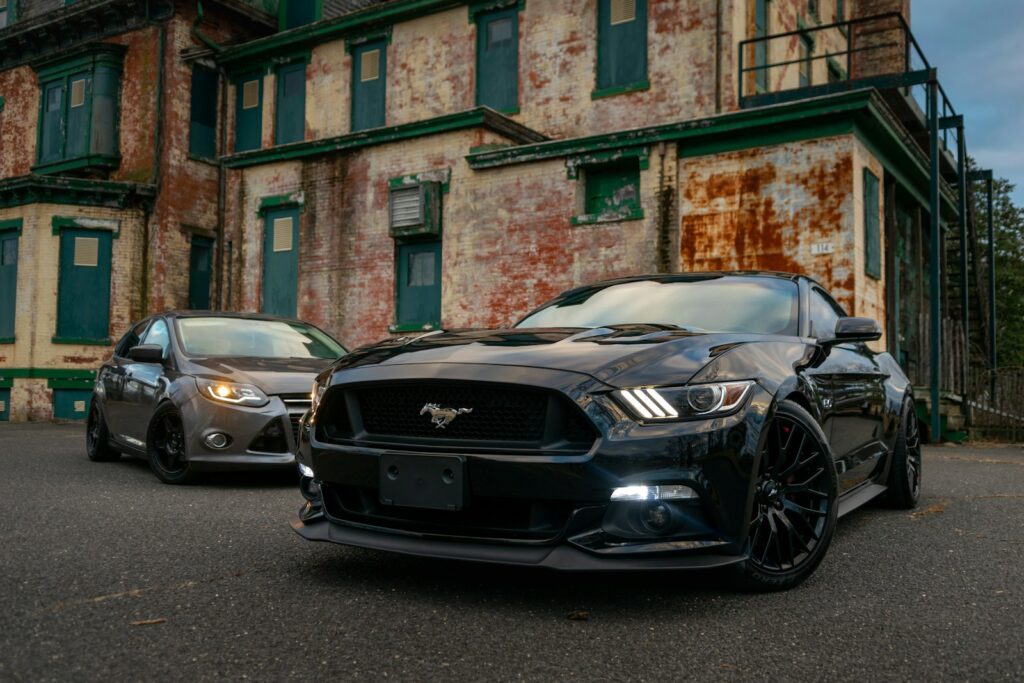
5. **There Are V10 Mustangs Out There – But You Won’t Get One**When you think of a Mustang, especially from the muscle and pony car era, V8 power is almost synonymous with its identity. Yet, in a fascinating twist of automotive history, Ford once toyed with the idea of stuffing a V10 engine under the hood of its iconic pony car. This wasn’t just a fleeting thought; actual prototypes were built, representing a powerful, albeit unofficial, chapter in the Mustang’s story.
During the 1990s, Ford found itself without a true “Corvette-beater” in its arsenal. The Dodge Viper, a fan-favorite supercar of the time, was the byword for stupid amounts of American power, and while the Mustang was significantly cheaper, it simply couldn’t keep up in terms of sheer brute force. A dedicated team of engineers decided to do something about this perceived power deficit.
Jim O’Neill and Greg Coleman of Ford’s Powertrain Research & Advanced Engines group began casting around for something special to install in the Mustang. They quickly discounted the existing 6.8-liter V10 Ford had available for its trucks, as it was too tall for the Mustang’s engine compartment. Undeterred, they embarked on an unsanctioned project to create their own solution, operating with “less oversight then,” as Jim O’Neill explained.
With help from fellow engineers, O’Neill and Coleman took a 4.6-liter V8 engine and ingeniously added a cylinder to each side. The result was a custom 5.8-liter V10, which reportedly produced an impressive 450 horsepower. This powerhouse was then installed under the hood of a 1999 GT model that had been slated for the crusher, giving it an unexpected new lease on life as a testbed for extreme performance.
O’Neill began promoting the new V10 configuration within Ford, sensing its potential to redefine the Mustang’s performance capabilities. However, the economic downturn of the mid-aughts unfortunately killed it as a potential production car, depriving enthusiasts of a new standard for Mustang power. And the Americans weren’t the only ones interested in a V10 Mustang; Ford Racing Australia took the concept to the next level by installing a supercharged 7.0-liter V10 in a 2000 model, showcasing the global desire for such an extreme machine.
Car Model Information: 2008 Ford Mustang GT Premium
Name: Ford Mustang
Caption: 2018 Ford Mustang GT 5.0
Aka: Ford T5 (Germany)
Manufacturer: Ford Motor Company
Production: March 1964 – present
ModelYears: 1965–present
Class: Unbulleted list
BodyStyle: Unbulleted list
Layout: Front-engine, rear-wheel-drive layout
Categories: 1970s cars, 1980s cars, 1990s cars, 2+2 coupés, 2000s cars
Summary: The Ford Mustang is an American automobile manufactured and marketed by Ford since 1964, as Ford’s longest nameplate in continuous production. Currently in its seventh generation, it is the fifth-best selling Ford car nameplate. The namesake of the “pony car” automobile segment, the Mustang was developed as a highly styled line of sporty coupes and convertibles derived from existing model lines, initially distinguished by its pronounced “long hood, short deck” proportions.
Originally predicted to sell 100,000 vehicles yearly, the 1965 Mustang became the most successful vehicle launch since the 1927 Model A. Introduced on April 17, 1964 (16 days after the Plymouth Barracuda), over 400,000 units were sold in its first year; the one-millionth Mustang was sold within two years of its launch. In August 2018, Ford produced the 10-millionth Mustang; matching the first 1965 Mustang, the vehicle was a 2019 Wimbledon White convertible with a V8 engine.
The success of the Mustang launch led to multiple competitors from other American manufacturers, including the Chevrolet Camaro and Pontiac Firebird (1967), AMC Javelin (1968), and Dodge Challenger (1970). It also competed with the Plymouth Barracuda, which was launched around the same time. The Mustang also had an effect on designs of coupes worldwide, leading to the marketing of the Toyota Celica and Ford Capri in the United States (the latter, by Lincoln-Mercury). The Mercury Cougar was launched in 1967 as a unique-bodied higher-trim alternative to the Mustang; during the 1970s, it included more features and was marketed as a personal luxury car.
From 1965 until 2004, the Mustang shared chassis commonality with other Ford model lines, staying rear-wheel-drive throughout its production. From 1965 to 1973, the Mustang was derived from the 1960 Ford Falcon compact. From 1974 until 1978, the Mustang (denoted Mustang II) was a longer-wheelbase version of the Ford Pinto. From 1979 until 2004, the Mustang shared its Fox platform chassis with 14 other Ford vehicles (becoming the final one to use the Fox architecture). Since 2005, the Mustang has used the D2C platform, unique to the Mustang.
Through its production, multiple nameplates have been associated with the Ford Mustang series, including GT, Mach 1, Boss 302/429, Cobra (separate from Shelby Cobra), and Bullitt, along with “5.0” fender badging (denoting 4.9 L OHV or 5.0 L DOHC V8 engines).
Get more information about: Ford Mustang
Buying a high-performing used car >>>
Brand: Ford Model: Mustang
Price: $16,785 Mileage: 81,832 mi.

6. **The First Cobra Was the Worst Mustang**The name “Cobra” has been associated with high-performance Ford Mustangs since its first generation, evoking images of Carroll Shelby’s legendary racers and powerful engines like the 428 Cobra Jet V8. It became a symbol of raw, untamed American muscle. However, a surprising twist in this storied lineage reveals that the very first official Ford Mustang Cobra arrived during what many consider the Mustang’s lowest point.
It wasn’t until the muscle car downturn of the 1970s, a period marked by rising fuel costs and stricter regulations, that Ford committed to building an official Mustang Cobra. Unfortunately, this idea came about during the tenure of the second-generation Mustang, commonly known as the Mustang II, which rolled around for the 1974 model year. The Mustang II era is often cited as an underwhelming chapter in the car’s history.
The 1974 Mustang II was underpowered, and many felt it lacked the iconic design and performance ethos of the original generation, leading to criticism from purists. It was during this period that Ford’s first Mustang Cobra arrived: the 1976 Cobra II. This model was a race-oriented variant, replete with signature racing stripes, a prominent hood scoop, a rear spoiler, and the very-70s window louvers, aiming to inject some performance credibility into the platform.
A further iteration, the King Cobra special edition, arrived in 1978. This was primarily a cosmetics upgrade, featuring a 302 ci V8, disc brakes, custom pinstriping, and distinctive snake decals, again attempting to enhance the Mustang II’s appeal. While the Mustang II hasn’t aged as gracefully as other generations and is often remembered for its compromises, it was popular in its day, and the King Cobra serves as an interesting, if somewhat ironic, footnote in its history.
Car Model Information: 2024 BMW X5 sDrive40i
Caption: 2004 Ford Mustang SVT Cobra
Name: Ford SVT Mustang Cobra
Manufacturer: Special Vehicle Team
Production: 1993–2004 (79,958 produced)
Assembly: Dearborn, Michigan
Class: Pony car
BodyStyle: 1993:,hatchback,coupe,convertible
Successor: Shelby Mustang#2007.E2.80.932009 Ford Shelby GT500
Platform: Ford Fox platform
Layout: Front-engine, rear-wheel drive layout
Categories: 2000s cars, All articles with specifically marked weasel-worded phrases, Articles with short description, Articles with specifically marked weasel-worded phrases from July 2025, Cars introduced in 1993
Summary: The Ford SVT Mustang Cobra (also known as “SVT Mustang Cobra, SVT Cobra,” or simply as “Cobra”) is a pony car that was built by American automobile manufacturer Ford Motor Company’s Special Vehicle Team division (or SVT) for the 1993 to 2004 model years.
The SVT Cobra was a high-performance version of the Ford Mustang and was considered the top-of-the-line variant, being positioned above the Mustang GT and Mach 1 models during its production run. On three occasions, the race-ready, street-legal SVT Cobra R variant was produced in limited numbers.
The SVT Cobra was succeeded by the Mustang Shelby GT500 which was introduced for the 2007 model year.
Get more information about: Ford Mustang SVT Cobra
Buying a high-performing used car >>>
Brand: Ford Model: Mustang Cobra
Price: $37,758 Mileage: 39,959 mi.
Read more about: Remember These Days? 14 Iconic Manual Transmissions That Vanished Or Are Fading From Our Car Options

7. **There Is No Official 1964 ½ Mustang**An oft-quoted piece of Mustang lore suggests that the very first model was a “1964 ½” model year. This seemingly precise designation has become embedded in enthusiast culture, implying a distinct, early production run. However, in the technical and official sense, this notion is both true and, perhaps more surprisingly, untrue, revealing a fascinating detail about the Mustang’s hurried and historic debut.
Ford famously debuted the original Mustang at the New York World’s Fair in April 1964. This was a significant departure from the typical automotive industry practice, where manufacturers usually unveiled new models in the autumn. The Mustang, being something of a rush project, simply wasn’t ready for a traditional fall launch, necessitating its springtime introduction that captivated the nation.
The Mustang’s late debut, however, is only half of the story. Ford continued to tweak and refine its newest family member throughout what would have traditionally been its inaugural production year. Consequently, enthusiasts began to informally split the original Mustang between models produced before and after August 1964, leading to the popular “1964 ½” designation for those early units.
Ford had projected to sell a respectable 100,000 Mustangs in its first year, but those plans were dramatically upended when a staggering 22,000 units flew off the lots on the very first day. Sensing that the inaugural Mustang was about to run away with the market, Ford rethought some aspects of its offering. Initially available as a coupe and convertible, the fastback body option appeared in late-1965, further complicating the unofficial “half-year” distinction.
Despite all this, Ford itself does not officially recognize a “1964 ½ Mustang,” formally referring to the entire first year as a 1965 model. Furthermore, no official registering offices or automotive nomenclature systems recognize half-years for vehicle models. The “1964 ½ Mustang” primarily refers to early-production 1965 models, though Ford has more recently started acknowledging its April 17, 1964, appearance at the World’s Fair as its official anniversary date, solidifying its historical starting point.
Read more about: Beyond Bond: Sean Connery’s Iconic Automotive Legacy – A Deep Dive into the Classic Cars He Made Famous
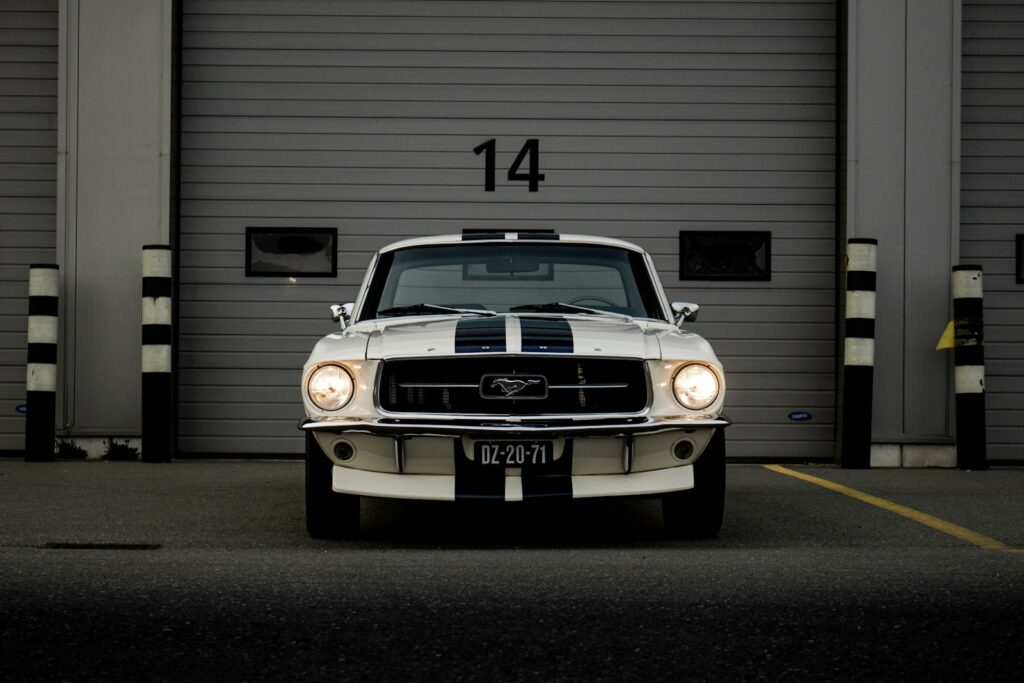
8. **The Mustang’s Most Enduring Era: The Fox Body’s Long Reign**While many Mustang generations have come and gone, leaving their unique marks on automotive history, one particular era stands out for its remarkable longevity and widespread appeal: the Fox Body Mustang. Spanning a remarkable 15 years, from 1979 to 1993, this generation holds the record as the longest-running in the Mustang’s storied past. It emerged during a challenging period for American automakers, responding to the shifting demands of the post-oil crisis market while somehow managing to capture the hearts of a new generation of enthusiasts.
What made the Fox Body so enduring? A significant part of its success lay in its lightweight chassis, a stark contrast to some of its heavier predecessors. This nimble foundation, coupled with a massive aftermarket support network, allowed owners and tuners to customize and enhance their vehicles in countless ways. It transformed the Fox Body from a mere mode of transportation into a highly personalizable performance machine, inspiring a passionate community that thrives to this day.
Beyond its mechanical attributes, the Fox Body Mustang cemented itself as a genuine cultural icon. Its distinctive lines graced everything from law enforcement patrol cars to the backdrops of rap music videos, showcasing its versatility and pervasive influence across different facets of American life. This era proved that the Mustang could evolve, adapt, and still resonate deeply with a broad audience, securing its place as a fan favorite and a testament to its enduring design.
Car Model Information: 2008 Ford Mustang GT Premium
Name: Ford Mustang
Caption: 2018 Ford Mustang GT 5.0
Aka: Ford T5 (Germany)
Manufacturer: Ford Motor Company
Production: March 1964 – present
ModelYears: 1965–present
Class: Unbulleted list
BodyStyle: Unbulleted list
Layout: Front-engine, rear-wheel-drive layout
Categories: 1970s cars, 1980s cars, 1990s cars, 2+2 coupés, 2000s cars
Summary: The Ford Mustang is an American automobile manufactured and marketed by Ford since 1964, as Ford’s longest nameplate in continuous production. Currently in its seventh generation, it is the fifth-best selling Ford car nameplate. The namesake of the “pony car” automobile segment, the Mustang was developed as a highly styled line of sporty coupes and convertibles derived from existing model lines, initially distinguished by its pronounced “long hood, short deck” proportions.
Originally predicted to sell 100,000 vehicles yearly, the 1965 Mustang became the most successful vehicle launch since the 1927 Model A. Introduced on April 17, 1964 (16 days after the Plymouth Barracuda), over 400,000 units were sold in its first year; the one-millionth Mustang was sold within two years of its launch. In August 2018, Ford produced the 10-millionth Mustang; matching the first 1965 Mustang, the vehicle was a 2019 Wimbledon White convertible with a V8 engine.
The success of the Mustang launch led to multiple competitors from other American manufacturers, including the Chevrolet Camaro and Pontiac Firebird (1967), AMC Javelin (1968), and Dodge Challenger (1970). It also competed with the Plymouth Barracuda, which was launched around the same time. The Mustang also had an effect on designs of coupes worldwide, leading to the marketing of the Toyota Celica and Ford Capri in the United States (the latter, by Lincoln-Mercury). The Mercury Cougar was launched in 1967 as a unique-bodied higher-trim alternative to the Mustang; during the 1970s, it included more features and was marketed as a personal luxury car.
From 1965 until 2004, the Mustang shared chassis commonality with other Ford model lines, staying rear-wheel-drive throughout its production. From 1965 to 1973, the Mustang was derived from the 1960 Ford Falcon compact. From 1974 until 1978, the Mustang (denoted Mustang II) was a longer-wheelbase version of the Ford Pinto. From 1979 until 2004, the Mustang shared its Fox platform chassis with 14 other Ford vehicles (becoming the final one to use the Fox architecture). Since 2005, the Mustang has used the D2C platform, unique to the Mustang.
Through its production, multiple nameplates have been associated with the Ford Mustang series, including GT, Mach 1, Boss 302/429, Cobra (separate from Shelby Cobra), and Bullitt, along with “5.0” fender badging (denoting 4.9 L OHV or 5.0 L DOHC V8 engines).
Get more information about: Ford Mustang
Buying a high-performing used car >>>
Brand: Ford Model: Mustang
Price: $16,785 Mileage: 81,832 mi.
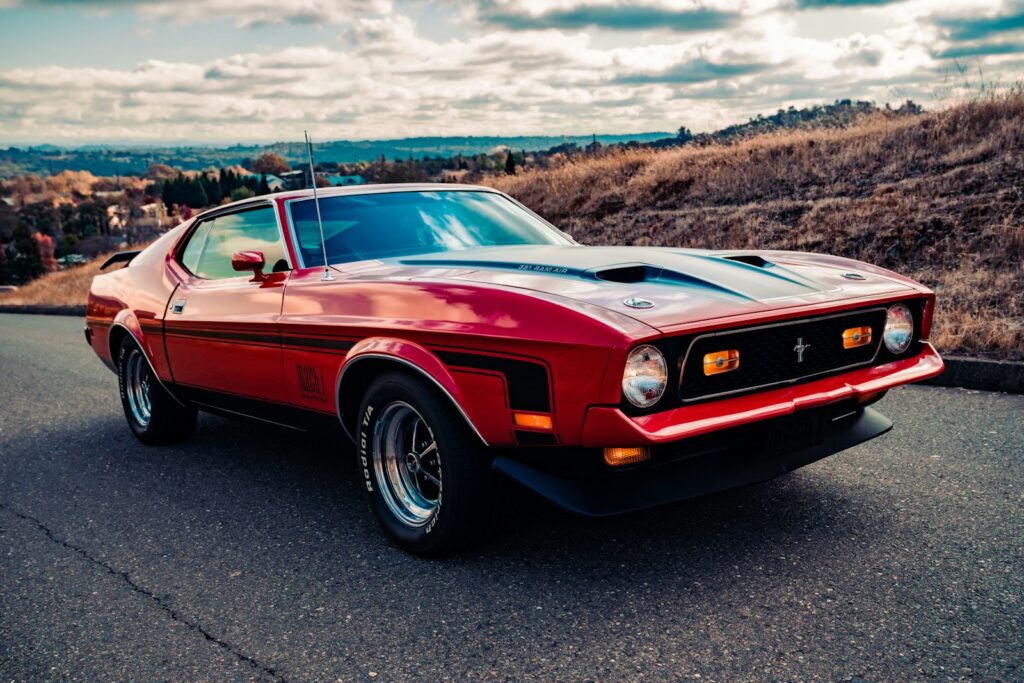
9. **Uniquely Mustang: Sequential Turn Signals Took Decades to Call Their Own**One of the most distinctive and beloved styling cues of the Ford Mustang is its sequential rear turn signals, a feature that adds a touch of sophistication and flair. Many enthusiasts associate this iconic lighting pattern directly with the Mustang’s identity, believing it to be an original design marvel from its early days. However, a surprising detail reveals that while sequential signals did appear on certain high-performance Mustangs in the late 1960s, they weren’t initially designed *specifically* for the pony car.
Indeed, the 1968-1970 Shelby GT350 and GT500 models proudly displayed these innovative turn signals, where the individual segments of the taillight illuminate in a cascading fashion. Yet, this captivating feature was actually borrowed from another Ford stablemate: the elegant Ford Thunderbird. For decades, what many perceived as a quintessential Mustang trait was, in fact, an adaptation from a different vehicle, a testament to Ford’s internal parts sharing and design efficiency at the time.
It wasn’t until much later, in 2010, that the Mustang finally received sequential rear turn signals designed entirely and uniquely for its own platform. This marked a significant milestone, as Ford committed to creating a bespoke lighting signature that truly belonged to the Mustang, establishing it as a proprietary styling cue that continues to evolve with each new generation. It’s a subtle yet fascinating piece of history, highlighting how even iconic features can have unexpected origins.
Car Model Information: 2008 Ford Mustang GT Premium
Name: Ford Mustang
Caption: 2018 Ford Mustang GT 5.0
Aka: Ford T5 (Germany)
Manufacturer: Ford Motor Company
Production: March 1964 – present
ModelYears: 1965–present
Class: Unbulleted list
BodyStyle: Unbulleted list
Layout: Front-engine, rear-wheel-drive layout
Categories: 1970s cars, 1980s cars, 1990s cars, 2+2 coupés, 2000s cars
Summary: The Ford Mustang is an American automobile manufactured and marketed by Ford since 1964, as Ford’s longest nameplate in continuous production. Currently in its seventh generation, it is the fifth-best selling Ford car nameplate. The namesake of the “pony car” automobile segment, the Mustang was developed as a highly styled line of sporty coupes and convertibles derived from existing model lines, initially distinguished by its pronounced “long hood, short deck” proportions.
Originally predicted to sell 100,000 vehicles yearly, the 1965 Mustang became the most successful vehicle launch since the 1927 Model A. Introduced on April 17, 1964 (16 days after the Plymouth Barracuda), over 400,000 units were sold in its first year; the one-millionth Mustang was sold within two years of its launch. In August 2018, Ford produced the 10-millionth Mustang; matching the first 1965 Mustang, the vehicle was a 2019 Wimbledon White convertible with a V8 engine.
The success of the Mustang launch led to multiple competitors from other American manufacturers, including the Chevrolet Camaro and Pontiac Firebird (1967), AMC Javelin (1968), and Dodge Challenger (1970). It also competed with the Plymouth Barracuda, which was launched around the same time. The Mustang also had an effect on designs of coupes worldwide, leading to the marketing of the Toyota Celica and Ford Capri in the United States (the latter, by Lincoln-Mercury). The Mercury Cougar was launched in 1967 as a unique-bodied higher-trim alternative to the Mustang; during the 1970s, it included more features and was marketed as a personal luxury car.
From 1965 until 2004, the Mustang shared chassis commonality with other Ford model lines, staying rear-wheel-drive throughout its production. From 1965 to 1973, the Mustang was derived from the 1960 Ford Falcon compact. From 1974 until 1978, the Mustang (denoted Mustang II) was a longer-wheelbase version of the Ford Pinto. From 1979 until 2004, the Mustang shared its Fox platform chassis with 14 other Ford vehicles (becoming the final one to use the Fox architecture). Since 2005, the Mustang has used the D2C platform, unique to the Mustang.
Through its production, multiple nameplates have been associated with the Ford Mustang series, including GT, Mach 1, Boss 302/429, Cobra (separate from Shelby Cobra), and Bullitt, along with “5.0” fender badging (denoting 4.9 L OHV or 5.0 L DOHC V8 engines).
Get more information about: Ford Mustang
Buying a high-performing used car >>>
Brand: Ford Model: Mustang
Price: $16,785 Mileage: 81,832 mi.
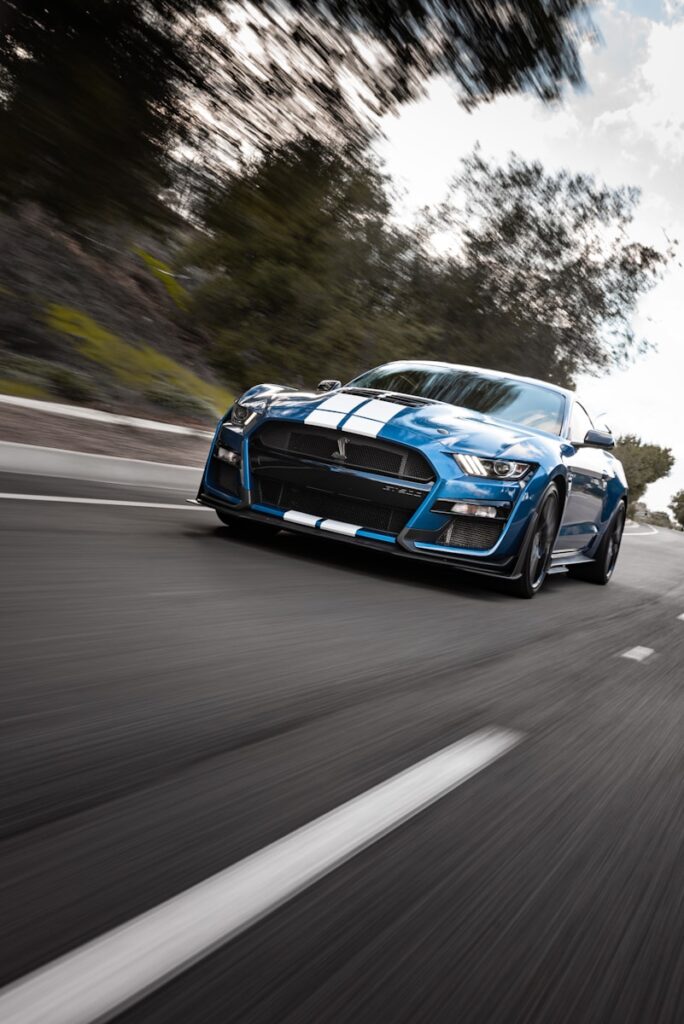
10. **The Unexpected Underachiever: Meet the Least Powerful Mustang Ever**When you envision a Ford Mustang, images of roaring V8 engines, blistering speed, and raw power often come to mind. It’s a car synonymous with performance, yet its extensive history includes an intriguing outlier that goes against this very grain. Believe it or not, the Mustang’s lineage includes a model widely recognized as the least powerful factory Mustang ever made, a stark contrast to its high-octane siblings.
This unlikely title belongs to the 1975 Mustang II, specifically when equipped with its 2.3-liter four-cylinder engine. In an era where the focus had dramatically shifted from sheer horsepower to fuel efficiency, this modest powerplant delivered a mere 87 horsepower. Such a figure pales in comparison to the mighty V8s of earlier and later generations, highlighting the drastic changes in automotive priorities during the mid-1970s.
Performance, as one might expect, suffered considerably with this configuration. The 1975 four-cylinder Mustang II took a rather leisurely 14 seconds to accelerate from 0 to 60 mph, a figure that certainly doesn’t scream “pony car.” However, it was capable of an impressive 34 miles per gallon, a crucial selling point at a time of rising oil prices. This unexpected underachiever, therefore, played a vital role in keeping the Mustang brand alive and relevant during challenging economic times, proving that adaptability can sometimes be more important than brute force.
Car Model Information: 2008 Ford Mustang GT Premium
Name: Ford Mustang
Caption: 2018 Ford Mustang GT 5.0
Aka: Ford T5 (Germany)
Manufacturer: Ford Motor Company
Production: March 1964 – present
ModelYears: 1965–present
Class: Unbulleted list
BodyStyle: Unbulleted list
Layout: Front-engine, rear-wheel-drive layout
Categories: 1970s cars, 1980s cars, 1990s cars, 2+2 coupés, 2000s cars
Summary: The Ford Mustang is an American automobile manufactured and marketed by Ford since 1964, as Ford’s longest nameplate in continuous production. Currently in its seventh generation, it is the fifth-best selling Ford car nameplate. The namesake of the “pony car” automobile segment, the Mustang was developed as a highly styled line of sporty coupes and convertibles derived from existing model lines, initially distinguished by its pronounced “long hood, short deck” proportions.
Originally predicted to sell 100,000 vehicles yearly, the 1965 Mustang became the most successful vehicle launch since the 1927 Model A. Introduced on April 17, 1964 (16 days after the Plymouth Barracuda), over 400,000 units were sold in its first year; the one-millionth Mustang was sold within two years of its launch. In August 2018, Ford produced the 10-millionth Mustang; matching the first 1965 Mustang, the vehicle was a 2019 Wimbledon White convertible with a V8 engine.
The success of the Mustang launch led to multiple competitors from other American manufacturers, including the Chevrolet Camaro and Pontiac Firebird (1967), AMC Javelin (1968), and Dodge Challenger (1970). It also competed with the Plymouth Barracuda, which was launched around the same time. The Mustang also had an effect on designs of coupes worldwide, leading to the marketing of the Toyota Celica and Ford Capri in the United States (the latter, by Lincoln-Mercury). The Mercury Cougar was launched in 1967 as a unique-bodied higher-trim alternative to the Mustang; during the 1970s, it included more features and was marketed as a personal luxury car.
From 1965 until 2004, the Mustang shared chassis commonality with other Ford model lines, staying rear-wheel-drive throughout its production. From 1965 to 1973, the Mustang was derived from the 1960 Ford Falcon compact. From 1974 until 1978, the Mustang (denoted Mustang II) was a longer-wheelbase version of the Ford Pinto. From 1979 until 2004, the Mustang shared its Fox platform chassis with 14 other Ford vehicles (becoming the final one to use the Fox architecture). Since 2005, the Mustang has used the D2C platform, unique to the Mustang.
Through its production, multiple nameplates have been associated with the Ford Mustang series, including GT, Mach 1, Boss 302/429, Cobra (separate from Shelby Cobra), and Bullitt, along with “5.0” fender badging (denoting 4.9 L OHV or 5.0 L DOHC V8 engines).
Get more information about: Ford Mustang
Buying a high-performing used car >>>
Brand: Ford Model: Mustang
Price: $16,785 Mileage: 81,832 mi.

11. **Breaking the 800-Horsepower Barrier: The Most Extreme Factory Mustang**From its early days as an affordable performance car, the Ford Mustang has consistently pushed the boundaries of power, evolving into a formidable force in the high-performance arena. While experimental V10 prototypes hinted at extreme potential in the past, a recent factory model has shattered all previous benchmarks, officially claiming the title of the most extreme and powerful factory Mustang ever built. This machine redefines what a production Mustang is capable of, blending race-inspired engineering with supercar-level performance.
Introducing the Ford Mustang GTD, a vehicle that boasts an incredible 815 horsepower, making it the first factory Mustang to exceed the monumental 800-horsepower mark. This astonishing figure isn’t just a number; it represents a pinnacle of engineering and design, born from Ford’s relentless pursuit of track dominance and street supremacy. The GTD is a testament to how far the pony car has come, transforming from a mainstream muscle car into a legitimate challenger to exotic supercars worldwide.
With such groundbreaking performance comes a commensurate price tag, as the Mustang GTD also holds the distinction of being the most expensive factory Mustang ever produced. Its bespoke nature, advanced aerodynamics, and meticulously crafted components justify its premium status, solidifying its position as a halo car for the brand. This powerful beast is a vivid demonstration that the Mustang, after six decades, continues to innovate, astound, and push the very limits of automotive engineering.
Car Model Information: 2008 Ford Mustang GT Premium
Name: Ford Mustang
Caption: 2018 Ford Mustang GT 5.0
Aka: Ford T5 (Germany)
Manufacturer: Ford Motor Company
Production: March 1964 – present
ModelYears: 1965–present
Class: Unbulleted list
BodyStyle: Unbulleted list
Layout: Front-engine, rear-wheel-drive layout
Categories: 1970s cars, 1980s cars, 1990s cars, 2+2 coupés, 2000s cars
Summary: The Ford Mustang is an American automobile manufactured and marketed by Ford since 1964, as Ford’s longest nameplate in continuous production. Currently in its seventh generation, it is the fifth-best selling Ford car nameplate. The namesake of the “pony car” automobile segment, the Mustang was developed as a highly styled line of sporty coupes and convertibles derived from existing model lines, initially distinguished by its pronounced “long hood, short deck” proportions.
Originally predicted to sell 100,000 vehicles yearly, the 1965 Mustang became the most successful vehicle launch since the 1927 Model A. Introduced on April 17, 1964 (16 days after the Plymouth Barracuda), over 400,000 units were sold in its first year; the one-millionth Mustang was sold within two years of its launch. In August 2018, Ford produced the 10-millionth Mustang; matching the first 1965 Mustang, the vehicle was a 2019 Wimbledon White convertible with a V8 engine.
The success of the Mustang launch led to multiple competitors from other American manufacturers, including the Chevrolet Camaro and Pontiac Firebird (1967), AMC Javelin (1968), and Dodge Challenger (1970). It also competed with the Plymouth Barracuda, which was launched around the same time. The Mustang also had an effect on designs of coupes worldwide, leading to the marketing of the Toyota Celica and Ford Capri in the United States (the latter, by Lincoln-Mercury). The Mercury Cougar was launched in 1967 as a unique-bodied higher-trim alternative to the Mustang; during the 1970s, it included more features and was marketed as a personal luxury car.
From 1965 until 2004, the Mustang shared chassis commonality with other Ford model lines, staying rear-wheel-drive throughout its production. From 1965 to 1973, the Mustang was derived from the 1960 Ford Falcon compact. From 1974 until 1978, the Mustang (denoted Mustang II) was a longer-wheelbase version of the Ford Pinto. From 1979 until 2004, the Mustang shared its Fox platform chassis with 14 other Ford vehicles (becoming the final one to use the Fox architecture). Since 2005, the Mustang has used the D2C platform, unique to the Mustang.
Through its production, multiple nameplates have been associated with the Ford Mustang series, including GT, Mach 1, Boss 302/429, Cobra (separate from Shelby Cobra), and Bullitt, along with “5.0” fender badging (denoting 4.9 L OHV or 5.0 L DOHC V8 engines).
Get more information about: Ford Mustang
Buying a high-performing used car >>>
Brand: Ford Model: Mustang
Price: $16,785 Mileage: 81,832 mi.
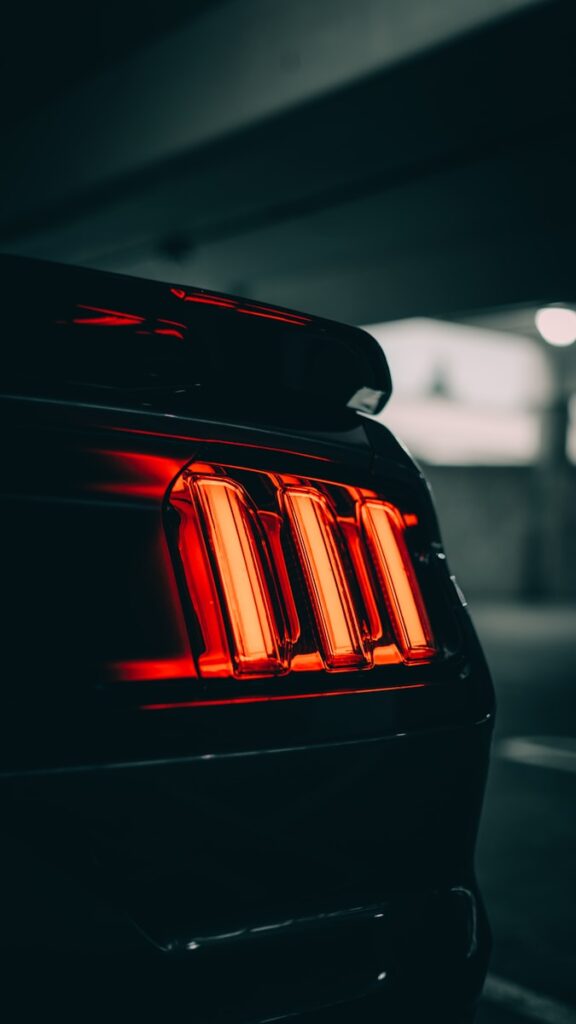
12. **A Sound Like No Other: The Mustang’s Flat-Plane Crank V8 Debut**While the rumble of a traditional cross-plane V8 engine is undeniably iconic to the American muscle car, the Mustang’s rich history includes a groundbreaking moment that introduced an entirely different, more exotic auditory experience. In 2015, the Shelby GT350 and GT350R models brought a major first to the Mustang lineup: a 5.2-liter Voodoo V8 engine featuring a flat-plane crank. This engineering marvel didn’t just boost power; it fundamentally altered the character and sound of the legendary pony car.
Unlike conventional V8s, the flat-plane crank configuration allows for a unique firing order that produces a higher-pitched, more frenetic exhaust note, reminiscent of European sports cars. This Voodoo V8 churned out an impressive 526 horsepower and, crucially, allowed the GT350 to rev exhilaratingly past 8,000 RPM. The result was an engine that not only delivered exceptional performance but also emitted an exotic soundscape never before heard in a Mustang, instantly setting it apart from its predecessors and contemporaries.
The introduction of the flat-plane crank V8 was a bold move that expanded the Mustang’s performance repertoire and appealed to enthusiasts seeking something truly unique. These GT350 and GT350R models quickly became some of the most sought-after Mustangs in history, celebrated for their track capability, distinctive engine, and, perhaps most notably, their unparalleled aural signature. It was a moment that proved the Mustang was not afraid to venture into new territory, embracing innovation to create an unforgettable driving experience.
Car Model Information: 2024 GMC Sierra 1500 SLT
Name: Shelby Mustang
Caption: 1965 Shelby Mustang GT350
Manufacturer: Unbulleted list
Aka: Unbulleted list
Production: Unbulleted list
Designer: John Chun
Assembly: Unbulleted list
Class: Unbulleted list
Platform: Unbulleted list
Related: Ford Mustang (first generation),Ford Mustang (fifth generation)
Layout: Front-engine, rear-wheel-drive layout
Categories: 1970s cars, 2000s cars, 2010s cars, 2020s cars, All Wikipedia articles written in American English
Summary: The Shelby Mustang is a high-performance variant of the Ford Mustang built by Shelby American from 1965 to 1967 and by the Ford Motor Company from 1968 to 1970.
In 2005, Ford revived the Shelby nameplate for a high-performance model of the fifth-generation Ford Mustang.
Get more information about: Shelby Mustang
Buying a high-performing used car >>>
Brand: Ford Model: Shelby GT350
Price: $43,759 Mileage: 32,694 mi.

13. **Still with Its First Owner: America’s Original Mustang’s Unbroken Bond**Among the countless stories of Mustang ownership, one truly stands out as a heartwarming and historically significant tale: the very first Ford Mustang sold in the United States remains with its original owner. This isn’t just a testament to the car’s enduring appeal; it’s a rare glimpse into a unique piece of automotive history that has been lovingly preserved through the decades, highlighting an unbreakable bond between a person and their legendary vehicle.
The remarkable journey began on April 15, 1964, when a young schoolteacher named Gail Wise purchased a Skyway Blue Mustang convertible from a Ford dealership in Chicago. What makes her purchase so extraordinary is that it occurred two full days *before* the Mustang’s official public reveal at the New York World’s Fair. The dealership mistakenly sold her a pre-release model, unknowingly making her the owner of the first U.S. Mustang and cementing her place in history.
Astonishingly, Gail Wise still owns that very same car today. Her dedication to preserving this irreplaceable piece of Mustang heritage is truly inspiring, a living testament to the instant connection many people felt with the car from its earliest days. Her story underscores not just the vehicle’s iconic status, but also the deep, personal connections that cars, especially one as beloved as the Mustang, can forge with their owners over a lifetime.
Car Model Information: 2008 Ford Mustang GT Premium
Name: Ford Mustang
Caption: 2018 Ford Mustang GT 5.0
Aka: Ford T5 (Germany)
Manufacturer: Ford Motor Company
Production: March 1964 – present
ModelYears: 1965–present
Class: Unbulleted list
BodyStyle: Unbulleted list
Layout: Front-engine, rear-wheel-drive layout
Categories: 1970s cars, 1980s cars, 1990s cars, 2+2 coupés, 2000s cars
Summary: The Ford Mustang is an American automobile manufactured and marketed by Ford since 1964, as Ford’s longest nameplate in continuous production. Currently in its seventh generation, it is the fifth-best selling Ford car nameplate. The namesake of the “pony car” automobile segment, the Mustang was developed as a highly styled line of sporty coupes and convertibles derived from existing model lines, initially distinguished by its pronounced “long hood, short deck” proportions.
Originally predicted to sell 100,000 vehicles yearly, the 1965 Mustang became the most successful vehicle launch since the 1927 Model A. Introduced on April 17, 1964 (16 days after the Plymouth Barracuda), over 400,000 units were sold in its first year; the one-millionth Mustang was sold within two years of its launch. In August 2018, Ford produced the 10-millionth Mustang; matching the first 1965 Mustang, the vehicle was a 2019 Wimbledon White convertible with a V8 engine.
The success of the Mustang launch led to multiple competitors from other American manufacturers, including the Chevrolet Camaro and Pontiac Firebird (1967), AMC Javelin (1968), and Dodge Challenger (1970). It also competed with the Plymouth Barracuda, which was launched around the same time. The Mustang also had an effect on designs of coupes worldwide, leading to the marketing of the Toyota Celica and Ford Capri in the United States (the latter, by Lincoln-Mercury). The Mercury Cougar was launched in 1967 as a unique-bodied higher-trim alternative to the Mustang; during the 1970s, it included more features and was marketed as a personal luxury car.
From 1965 until 2004, the Mustang shared chassis commonality with other Ford model lines, staying rear-wheel-drive throughout its production. From 1965 to 1973, the Mustang was derived from the 1960 Ford Falcon compact. From 1974 until 1978, the Mustang (denoted Mustang II) was a longer-wheelbase version of the Ford Pinto. From 1979 until 2004, the Mustang shared its Fox platform chassis with 14 other Ford vehicles (becoming the final one to use the Fox architecture). Since 2005, the Mustang has used the D2C platform, unique to the Mustang.
Through its production, multiple nameplates have been associated with the Ford Mustang series, including GT, Mach 1, Boss 302/429, Cobra (separate from Shelby Cobra), and Bullitt, along with “5.0” fender badging (denoting 4.9 L OHV or 5.0 L DOHC V8 engines).
Get more information about: Ford Mustang
Buying a high-performing used car >>>
Brand: Ford Model: Mustang
Price: $16,785 Mileage: 81,832 mi.

14. **Driving on the Other Side: The Mustang’s Surprising Delay in Right-Hand Drive**Despite the Ford Mustang’s global renown and widespread admiration, an interesting fact often escapes even seasoned enthusiasts: factory-built right-hand drive (RHD) versions of the iconic pony car took an incredibly long time to officially arrive. While the Mustang has been a symbol of American automotive prowess for decades, its full international accessibility in its native form was a surprisingly late development, considering its immense popularity worldwide.
Many significant global markets, including the United Kingdom, Australia, Japan, South Africa, and India, drive on the left side of the road, necessitating vehicles with the steering wheel and controls on the right. For years, enthusiasts in these countries who desired a Mustang either had to import left-hand drive models and have them converted (often unofficially) or settle for quasi-official conversions. For instance, the Australian engineering firm Tickford Vehicle Engineering produced some RHD Cobras and convertibles between 2001 and 2003, with Ford’s blessing, but these weren’t direct factory productions.
The true milestone finally came in 2015 with the debut of the Mustang’s sixth generation. This marked the first time Ford officially produced factory-built right-hand drive Mustangs, making the vehicle directly accessible to a massive, eager international audience. The demand was immediate and overwhelming, with 4,000 buyers in Australia alone joining a 12-month pre-sold waiting list before its release. This belated but crucial move solidified the Mustang’s status as a truly global sports car, proving that good things, even global Mustangs, are worth waiting for.
The Ford Mustang, as we’ve journeyed through its remarkable history, is clearly more than just a car; it’s an evolving legend woven into the very fabric of American culture and automotive innovation. From its unexpected prototypes and naming origins to its surprising design pivots and groundbreaking performance milestones, the Mustang continually surprises and delights. Its story is a vibrant tapestry of ingenuity, resilience, and an enduring ability to capture the public imagination, inspiring generations to dream of the open road. As it continues its incredible journey, one thing is certain: the Mustang will undoubtedly keep delivering exhilarating moments and hidden gems for enthusiasts to discover, forever cementing its status as an iconic, one-of-a-kind marvel.”
Car Model Information: 2008 Ford Mustang GT Premium
Name: Ford Mustang
Caption: 2018 Ford Mustang GT 5.0
Aka: Ford T5 (Germany)
Manufacturer: Ford Motor Company
Production: March 1964 – present
ModelYears: 1965–present
Class: Unbulleted list
BodyStyle: Unbulleted list
Layout: Front-engine, rear-wheel-drive layout
Categories: 1970s cars, 1980s cars, 1990s cars, 2+2 coupés, 2000s cars
Summary: The Ford Mustang is an American automobile manufactured and marketed by Ford since 1964, as Ford’s longest nameplate in continuous production. Currently in its seventh generation, it is the fifth-best selling Ford car nameplate. The namesake of the “pony car” automobile segment, the Mustang was developed as a highly styled line of sporty coupes and convertibles derived from existing model lines, initially distinguished by its pronounced “long hood, short deck” proportions.
Originally predicted to sell 100,000 vehicles yearly, the 1965 Mustang became the most successful vehicle launch since the 1927 Model A. Introduced on April 17, 1964 (16 days after the Plymouth Barracuda), over 400,000 units were sold in its first year; the one-millionth Mustang was sold within two years of its launch. In August 2018, Ford produced the 10-millionth Mustang; matching the first 1965 Mustang, the vehicle was a 2019 Wimbledon White convertible with a V8 engine.
The success of the Mustang launch led to multiple competitors from other American manufacturers, including the Chevrolet Camaro and Pontiac Firebird (1967), AMC Javelin (1968), and Dodge Challenger (1970). It also competed with the Plymouth Barracuda, which was launched around the same time. The Mustang also had an effect on designs of coupes worldwide, leading to the marketing of the Toyota Celica and Ford Capri in the United States (the latter, by Lincoln-Mercury). The Mercury Cougar was launched in 1967 as a unique-bodied higher-trim alternative to the Mustang; during the 1970s, it included more features and was marketed as a personal luxury car.
From 1965 until 2004, the Mustang shared chassis commonality with other Ford model lines, staying rear-wheel-drive throughout its production. From 1965 to 1973, the Mustang was derived from the 1960 Ford Falcon compact. From 1974 until 1978, the Mustang (denoted Mustang II) was a longer-wheelbase version of the Ford Pinto. From 1979 until 2004, the Mustang shared its Fox platform chassis with 14 other Ford vehicles (becoming the final one to use the Fox architecture). Since 2005, the Mustang has used the D2C platform, unique to the Mustang.
Through its production, multiple nameplates have been associated with the Ford Mustang series, including GT, Mach 1, Boss 302/429, Cobra (separate from Shelby Cobra), and Bullitt, along with “5.0” fender badging (denoting 4.9 L OHV or 5.0 L DOHC V8 engines).
Get more information about: Ford Mustang
Buying a high-performing used car >>>
Brand: Ford Model: Mustang
Price: $16,785 Mileage: 81,832 mi.
, “_words_section2”: “1945

